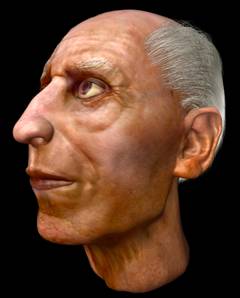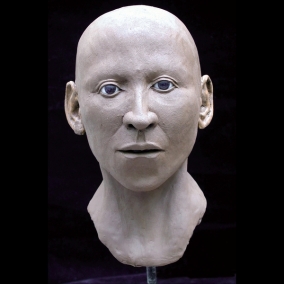I’m in an Egyptian mood this week.
There have been a few reconstructions of Egyptian mummies, and I’ve done my best to track them all down.
Lets start with the really big names first.
Ramses II
This is a slightly incorrect reconstruction, as the very elderly king (in his nineties) had his hair hennaed to a light auburn colour to make him look younger. It’s also likely, since he was a natural red head (and of Libyan descent) that his skin tone was a few shades lighter, as nobles wouldn’t have gone out in the sun much.
Tutankhamun.
The Mummy of King Tutanhkamun was carefully placed in a cat scanner, and an image made of his skull, created without damaging him.They gave a model of the skull to three teams, one American, one Egyptian and one French. They then let them all use their varying techniques. This very lifelike one is the French reconstruction with a silicon skin.
These computer rendered images also support the French reconstruction. The grey one is the American one, and they were working blind on it. They identified it as a Caucasian North African, and after taking a little time to decide the sex (as he had a very feminine skull) they come up with the very weak chinned young man you see here. The jawline on the Egyptian one is somewhat stronger (suspiciously so). I think they may have ‘butched him up’ a touch.
‘Nefertiti’
First of all I’d like to say that this looks absolutely nothing like the bust of her. The busts of Nefertiti all have much thinner lips and the face is less angular with rounder cheekbones, and the shape of the eyebrows is totally wrong. The skin tone is also well off the skin colour of the bust, she’s a should be a much pinker tone. But, it may well be an accurate representation of the mummy it’s of, as the identity of Nefertiti is up for debate. I think the fact that this recon doesn’t look anything like the bust suggests it’s not Nefertiti they’ve got their hands on here.
Asru
Asru was a chantress (temple singer) of fifty or sixty years old. When she died she appeared to have been in poor health for quite some time, suffering a slipped disc, ear infection and a cyst due to a parasitic infection that would have caused shortness of breath and chest pain. She also suffered from schistosomiasis.
Harwa.
This man dates from the twenty second or twenty third dynasty, about 945–715 BC. There’s a link to the reconstruction process here.
Pesed and ‘Bess’
Pesed was a fifty five to seventy year old woman from 300 BC, who lived in Akhmim.
‘Bess’ was five feet tall and died between 25 and 35. She was likely from a wealthy family and died died 3,000 to 3,500 years ago. She was modeled by high-resolution CT scans, which captured detailed visual slices every millimeter.
Nefer-ii-ne and Natsef Amun
Nefer-ii-ne dates to around 250 BC. She looks a lot like like a Nigerian comedienne you see on British TV, and appears to be fairly prognathic, so I’m guessing she had pretty dark skin, as does the man next to her…
Natsef Amun was a priest at the temple of Karnak from 1,100 BC. He died in middle age. He appears to be strongly Nubian in appearance, which isn’t uncommon in Upper (Southern) Egyptians
Nesperennub
Recently reconstructed by the British museum. He died about 800 BC. There’s a link to the Museum article on the reconstruction here. If you think the cat scan image is a bit odd, it’s because he’s wearing a bowl on his head. Apparently as part of the mummification process.
Ta-irty bai


Reconstructed from a CT scan by the Akhmim Mummy Studies Consortium. She dates to the 3rd century BC. She was aged 35 to 40 when she died, about the average for ancient Egypt.
‘Annie’ and Peten-Amun


This is the body of an unnamed teenage girl from Akhmim circa 250 BC.
Peten-Amun was a minor priest from the early Ptolemaic era (300 BC) who died aged about sixty, a long life by Egyptian standards.
Bodiless mummy head


Digitally reconstructed. You can see his grey beard and thin hair more clearly on the mummy though.




















Hi mathilda I ws not aware that Rames II line came from Lybia. I knew they were not of the older Royal but worked up through the milatary and took over after the colaspe of the last of the 18th dynasty( the Atenist like Ankenanten, Tut).That would explain how other tenth century pharos rose to power that
were also of lybian decent.
The boll on top of Nesperennub’s head seems to have been used as part of the embalming process.
Also it intresting that Ramses was lybian descent since he led campians againts lybians.
http://www.britishmuseum.org/explore/highlights/highlight_objects/aes/m/mummy_of_nesperennub.aspx
I think Ramses lead campaigns against everyone.
True Ramses did do that. and most certanly if you were in the levant and sided with the Hittites.Though the fact there were lybian groups like the Libu that raided egypt give us any sign what the social structe was in lybia? Was there any stucture at all as we see in egypt or was it all nomadic?
http://en.wikipedia.org/wiki/Libu
Possible that the Ramseihed family had maintianed no relations with lybia and saw lybia as an other nation.
True any nation was part of his campians. It seems as thought the Ramseshide family did not maintian any relations with the old country though.
However the fact lybians like the Libu had become raiders of egypt rais quetions how structured Lybia was. Were they nomads through out egyptian histrory or did they have some organsation beyond tribal.
http://en.wikipedia.org/wiki/Libu
Yes the lead campians against any nation.The
fact though there were lybians like the libu
leading raids against egypt raises questions about their level of organsitation. Did the
Lybians ever have any level of nation unity or were they allways tribal?
http://en.wikipedia.org/wiki/Libu
Yes Ramses lead campians against any nation.The fact though there were lybians like the libu leading raids against egypt raises questions about their level of organsitation. Did Lybia ever have any level of nation unity or were they allways tribal?
http://en.wikipedia.org/wiki/Libu
Neferdit is very very beautiful lowee
Hello!
I’m Bernadette from Hungary, a graphician working in a museum. I tried to draw a facial reconstruction about Ramessses the II, using my own sketches taken in Cairo. I search for any reconstructions still exists but i also know only the Manchester’s one.
may you know an other reconstruction is still exists?
I heard about a japanese team, they did and also presented a reco’ using the X-rays were taken by Professor Faure, but they didn’t accessible.
Thank you
Kind regards
Bernadette Andics Hungary
Sorry Bernadette, this is the only one I could find.
Well, I”m totally fascinated with your site. I’ve been interested in Egyptian art since the early seventies and find your site noteworthy.
king tut was not white,he was black. you could see .
yes you’re right mace…the original king tut reconstruction done many years ago…shows him as black..and Susan Anton…one of the anthropologists who worked on the second, much more famous reconstruction of him (she operated blindly, meaning she originally didn’t know whose crania it was)), said that his skull exhibited many “typical African features”…
Susan Anton actually said that he could have been lighter in colour, and that she was fine with the details of the reconstruction. I have it on the blog somewhere. AHAH>
You are mistaking ‘African’ for ‘black African’ John. Egyptians are an African populaiton, and have been for about the last 8k.
this is pure disgusting btw:O
GADS …………………………………………………….
Thanks for stating that the reconstructed face if the unknown mummy is emphatically NOT Nefertitti! I just watched that show and I swore out loud it didn’t the least resemble the bust also
You should add the ones mentioned here:
http://tinyurl.com/facial-reconstructions
Click to access 3d%20Proportion%20and%20personality.pdf
this is pure disgusting btw:O
GADS…………….
RAMSES II IS THE KING OF THE AGE OF MOISES
Mummy Ramses 2zx
Mummy Ramses 2weqw
I don’t mean to be picky but you left out some really important pharaohs of all time like : Hatshepsut, Khufu, and Senusret. I only said this b/c I’m 14 and have a whole quarter of school on this stuff and a bunch of my friends wanted to know if any of them were on this website, but they weren’t (plus I want to major of social studies when i get older and I thought they were important) ~KJ
and by the way King Tut was white, he was not black I did a 7 page essay on him, and my mom’s professor in collage help me out.
Referring to the reconstruction of Tutankamun above, silicon is a mineral element; silicone is a synthetic polymer.
Mathilda, why do you say that Ramses the Great was of Libyan descent? I’ve never heard this before.
Mathilda, why do you say that Ramses the Great was of Libyan descent?
His dynasty was originally the reultt of Libyan settlers in Egypt.
wow! im doing a school report about Ramesses II. Did i spell it right? scary, but cool pictures!
Its great and it showed me some of the kings and queens (pharoahs) of Egypt